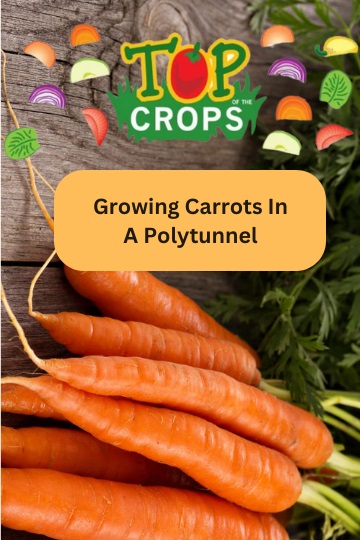Welcome to Top of the Crops! Today, you will learn about how to grow carrots in a polytunnel. Learn everything that there is to know about growing carrots in the UK.
Carrots are a popular crop for home growing, and growing your own is a great way to try some more unusual carrot varieties that are not as readily available to buy. There are many heirloom or heritage carrot varieties to try, and a polytunnel garden is the perfect place to grow them.
Carrots are a root vegetable - the roots of the plant Daucus carota. Typically orange in colour these days, this vegetable can come in a range of hues including purple, red, white and yellow as well as the typical orange hue.
Carrots are biennial plants, they grow roots and foliage growth in their first year, and flower in their second, setting seed before ending their lifecycle. Selectively bred over many centuries for plump, sweet roots, there are numerous cultivars to choose from if you want to grow carrots in your garden.
| Jan | Feb | Mar | Apr | May | Jun | Jul | Aug | Sep | Oct | Nov | Dec | |
| Sow |  |
 |
 |
 |
 |
 |
||||||
| Harvest |  |
 |
 |
 |
 |
 |
If you would like to grow carrots in your polytunnel, or elsewhere in your garden, then the first thing you need to understand is what growing conditions carrots require. The most important things to think about when it comes to the environmental conditions are temperatures, sunlight, and soil.
Carrots need temperatures between 15 and 18 degrees Celsius to perform optimally and produce the best yields. They can cope with air temperatures down to around 7 degrees C. however, though lower temperatures reduce yields and increase chances that the crop will bolt.
Carrots will always grown best in full sun, though they can appreciate a little shade during extremely hot summers.
Carrots can be grown in the ground, in raised beds, or in containers. The soil or growing medium, however, should be light, well-drained and fertile for carrots to grow well.
If the soil is rocky or a heavier clay, carrot roots can fork and become badly misshapen, and it is best to opt for shorter rooted varieties as well as taking steps to improve the soil for carrot cultivation.
To grow carrots you will need:
Carrot seeds of the variety or varieties that you have chosen to grow.
A suitable growing location, with good soil or growing medium.
Organic mulch material to lay around your crop.
Netting or row cover to protect your crop (along with companion plants like onions).
A garden fork to harvest your carrot crop.
Growing carrots at home from seed is not particularly challenging, though the seeds are small and may not always germinate successfully if you do not provide ideal conditions for the seeds to sprout or choose the wrong time to sow where you live.
Depending on where you live in the UK, you might be able to sow carrot seeds where they are to grow with the protection of cloches or row covers as early as February or March. A polytunnel makes early sowing easier when you are growing carrots in most regions.
Outdoors, carrots are typically sown between April and early July. Early carrots are typically sown earlier in this time period, while maincrops are sowed a little later.
It is best to direct sow carrots where they are to grow as they do not respond well to transplantation. Sow thinly in 1cm deep drills made around 15-30cm apart.
Since carrot seeds can be slow to germinate, it is a good idea to sow radish seeds alongside them. The radish seeds will usually germinate much more quickly, marking the rows. And they will be harvested before the carrots need the space.
It is a good idea to sow successionally. Sow small batches of carrots every 3-4 weeks for continuous harvests.
Thin out the seedlings once they emerge as needed, aiming for an eventual spacing of around 5-7.5cm between plants.
You can also if you wish sow carrot seeds into containers, rather than into the ground. Remember, plants in pots will take more work, especially when it comes to watering. But it is possible to grow carrots in containers as long as you choose containers that are as deep as possible, and filled with a good quality, moist yet free draining, peat-free potting mix.
In the restricted space of a container, round or short rooted carrots are generally better options than those with long, slender roots.
Again, sow seeds around 1cm deep, and aim for an eventual spacing of 5-7.5cm between the plants.
Carrots in the ground do not require a great deal of care, and even those in containers that will take more work are still pretty easy to grow successfully.
Carrots in the ground or a raised bed will not usually require watering outdoors, except during prolonged dry spells.
In a polytunnel, of course, you will need to provide consistent watering or irrigation. And in containers, more watering will be required as the growing medium can dry out more quickly.
Carrots are not tolerant of competition and so it is important to remove weeds promptly from between them. It is best to hand weed around carrots if possible, to avoid damaging the top of the root, though you can carefully hoe to remove weeds between rows if you need to.
Try to be quick when weeding and avoid brushing against the foliage and releasing its smell as much as you can. Carrots should usually be covered most of the time to reduce the chances of a carrot fly infestation taking hold.
Covering your carrot crop with a physical mesh or netting barrier is the best way to prevent a carrot fly infestation on a carrot crop. This should be in place as much of the time as possible, and pegged down carefully around the edges.
Companion planting is another important way to protect your carrots from carrot fly and other common pests. Onions are one of the best companion plants for carrots, since they give off a strong scent that masks the scent of carrots and 'hides' them from carrot flies. Carrots also benefit onions by giving off a scent that can confuse onion flies.
Carrot flies are one of the most problematic pests you can encounter when growing carrots. Slugs and snails can also pose a problem early in the carrots' lives. Rodents may also sometimes eat the seeds before they get the chance to germinate, or soon after germination, so this is something else to look out for.
Most of the time, however, the most common issues encountered when growing carrots relate to improper placement or care. So make sure you choose the right location to grow your carrots, and care for them correctly, to avoid many of the most common pitfalls.
Carrots will be ready to harvest around 12-16 weeks after you have sown the seeds. You can harvest the edible roots at any time – there is no minimum size and you can eat the thinned plants as baby carrots while they are still very small.
Many carrots are also at their best when they are small – remember the goal should not be to get the biggest roots possible but rather to get sweet, well-textured roots that are at their best for eating. Harvest early carrots as soon as they reach a reasonable size.
Maincrop carrots are usually harvested towards the tail end of the season. They are best lifted with a garden fork rather than pulled to prevent breakages.
There are many carrot recipes to consider so you should find plenty of ways to make use of the crop you have grown.
You can of course eat your carrots right away. But healthy and undamaged carrots can also be kept in the fridge for a week or so, or blanched then frozen.
Maincrop carrots can be lifted and stored in a traditional root cellar or similar space in trays or boxes of damp sand. Or they can be protected from frost with straw, dried leaves or other insulating mulch and left in the ground to be harvested as needed over the winter months.
There are a huge range of carrot varieties to consider. Those that have been given an award of garden merit by the RHS could be a good place to start. The AGM carrot varieties recommended at present are:
‘Adelaide’
‘Amsterdam Forcing 3’
‘Artemis’
‘Bangor’
‘Deep Purple’
‘Eskimo’
‘Extremo’
‘Flyaway’
‘Ideal Red’
‘Maestro’
‘Marion’
‘Nairobi’
‘Napoli’
‘Primo’
‘Romance’
‘Silvano’
‘Sugarsnax 54’
‘Sweet Candle’
‘Tozresis’
So these could be a good place to begin when looking for carrot varieties to grow in the UK, as well as knowing when is harvest season.
Carrots make excellent polytunnel crops as they like the often relatively dry conditions found inside better than they like the rain of many British summers.
Grow them in a bed intercropped with onions and perhaps other companion plants, and remember to rotate this crop so you don't grow carrots in the same place year after year.
Sow carrots at the right times in a polytunnel and provide them with the right protection and you could be eating your own home grown carrots all year round.
A Couple Cooks. (2023) 20 Easy Carrot Recipes. Sonja and Alex. [online] Available at: https://www.acouplecooks.com/carrot-recipes/ [accessed 14/12/23]
